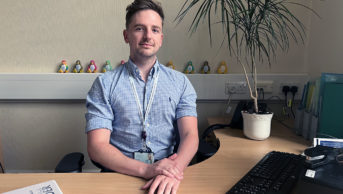
Patryk Poniatowski
For many of us, 2020 was a life-changing year in our lives and careers as pharmacists. It was in my case — in March 2020, I was redeployed from a busy acute district general hospital to work as a full-time clinical pharmacist at Ysbyty Cwm Rhondda, a peripheral community hospital in the South Wales Valleys.
Some might perceive this as a demotion; there is a certain stereotype that associates community hospitals with a slower pace of work, extended stay patients and a repetitiveness that does not utilise the full repertoire of a pharmacists’ clinical skills. Our patients’ problems range from post-stroke, complex social cases to severely impaired cognition, which may lead to the assumption that the pharmacist’s role is not pivotal; however, my perception is totally different. I saw a golden opportunity; a close-knit team where clinical pharmacists could develop and showcase their skills in supporting these complex patients’ care.
When I arrived, I found that pharmacy was not fully integrated into the wider hospital multidisciplinary team (MDT). It operated as a small department at the peripheries of the hospital, with the occasional pharmacist spotted in the distance. I set out to change the perception of pharmacy — integration into a more clinical role while being visible to clinicians on the wards.
08:15 – start
Today at 09:00, I start a ward round. Arriving 45 minutes beforehand allows me to organise the day: estimating potential discharges and finding any new patients admitted; making a detailed handover list; and making time before the ward round to answer any queries from the nurses and other healthcare professionals.
Our patients often have extended stays; from two weeks up to a year, so there is an opportunity for me to gain detailed and in-depth knowledge about them. This enables us, as pharmacists, to contribute to the MDT discussions and make recommendations for patients’ treatment. James Bolt, the consultant with me on today’s ward round, is enthusiastic about developing the pharmacist role in the clinical setting. He frequently sees issues with polypharmacy in our patients, and deprescribing has become a real focus in optimising his patients’ care. I ensure this matter is covered for each patient in my personal handover list, ready for the ward round.
09:00
During the ward round, the clinicians and I discuss the appropriateness of each patients’ treatment, focusing on key points such as polypharmacy and options to improve compliance. For instance, we often stop medications, such as proton pump inhibitors — which are being taken for long periods without review — and look at different formulations.
Today’s cases include three patients that were transferred from acute sites after fractures. While reviewing their notes, I’ve identified that their pain management plan was not clearly documented. As a consequence, these patients were continuously taking strong opioids, despite being pain-free. Before the ward round, I took the opportunity to educate the patients about the benefits and drawbacks of long-term opioid use. Together with the team and these patients, we later came up with a plan to slowly taper the opioid treatment and monitor their pain closely.
The same group of patients was suffering from severe constipation; instead of starting an additional medication for constipation, we trial a meal plan with increased fibre intake.
10:30
Straight after ward round, I attend the ward’s MDT meeting. Our patients typically have both health and social care needs, which make most discharges complex and multifactorial. Pharmacists are a really important part of the MDT: in addition to our role in reviewing medicines, we work with the team to ensure that solutions are put in place to support patients in taking their medicines when they leave hospital. This is particularly important because many of our patients have had an extended hospital stay and also a deterioration in function, which can result in them becoming de-skilled in managing medicines independently.
To help manage this, I undertake self-medication assessments with patients, as part of preparations for discharge, to identify those who need additional support in taking their medication while maintaining their independence at home. We trial compliance aids, and are able to refer patients to our medication administration service if patients are unable to take their medication without this level of support. Wherever we implement changes to support patients, we discuss these with our community colleagues in GP practices and community pharmacies to ensure continuity of care.
Our team has brilliant pharmacy technicians, and I see medicines management technicians as integral to supporting patients to remain independent in managing their medicines at home. That is why I hope that, soon, MDT meetings will also be attended by one of my technician colleagues so that, in addition to working within the reablement team, they can help ensure that patients medication needs are assessed and appropriate support is arranged as part of the discharge planning process.
Within our multi-sector preregistration pharmacy technician programme, integration with our community based ‘Your Medicines@Home’ and community pharmacy technician colleagues is in progress. We plan to develop this further by commissioning community pharmacy technician-led services to follow up patients discharged with additional support.
12:00
Midday is usually the moment when new patients arrive on the wards. After checking their medication history, I study their pharmacotherapy and look at how their treatment should be optimised. All of this information will be transferred to my handover ready for the next ward round.
This time of day is also ideal for monitoring our long-stay patients. Being able to closely monitor changes in the hospital environment means we can manage complex issues, such as pain management and mental health, providing reassurance to both clinical staff and patients that the changes improve outcomes and reduce harm. With this in mind, I work closely with the primary care mental health and pain specialist pharmacists, ensuring that prescribing is aligned and followed up where needed once the patient is discharged.
14:00
After my lunch, I spend about half an hour vaccinating staff against flu in the pharmacy department and get to meet a few new faces from around the hospital. I undertook immunisation training to become a flu peer vaccinator, which allowed me to develop drop-in flu clinics within the hospital. So far, I’ve vaccinated around 40 staff and have found this a great way to develop my relationships with the clinical teams across the hospital.
15:30
I always keep in mind that, apart from my routine tasks, our value in the clinical team must be backed up with real data. Bearing this in mind — and also with my own interest in quality improvement — I conducted a quality improvement project (QIP) in antibiotic prescribing. This afternoon I analysed the data from two cycles of the QIP, and the results will be presented to clinical staff working throughout the hospital soon.
In the afternoons, I will also catch up with the senior pharmacists in the department. It’s really helpful to utilise their expertise and guidance on problems that have cropped up throughout the day, and together we set targets and work towards solutions.
16:30
By the end of the day, I ask all of the nursing staff on the wards about any final medication orders or any queries that should be resolved before closing our department.
Interestingly, our hospital has started to be perceived as a communication link between primary and secondary care. Consequently, after the last order I follow up and answer a GP’s queries about a recently discharged patient. They want to know the indication and expected duration of treatment with a newly started novel oral anticoagulant. I answer their queries and ensure the appropriate documents have been forwarded to them about the discharge.
After answering the last email and closing my laptop, I ensure my handover list is up to date, ready to start a new day tomorrow.
Are you interested in a similar role?
- My role is NHS agenda for change band 7–8a
- Ideally, you should have a postgraduate clinical diploma and independent prescribing qualifications
- You must have a friendly attitude, be non-judgmental and able to develop good rapport with patients and staff
- Be passionate about learning. My continuous development focuses on deprescribing and polypharmacy. I find Centre for Pharmacy Postgraduate Education courses about polypharmacy, and materials provided by the website www.deprescribing.com and the English Deprescribing Network, particularly useful.
- Use every opportunity to attend conferences and workshops if possible. This is a perfect opportunity for networking and getting some inspiration for your further development
- Be individual — our role in community hospitals is not fully developed. Creating your own targets and showing your value in the team is a substantial part of your development.
